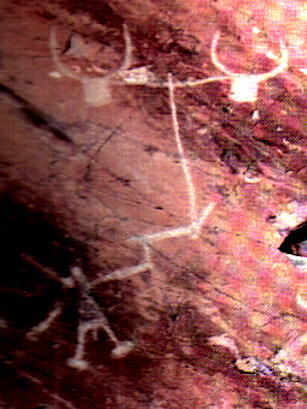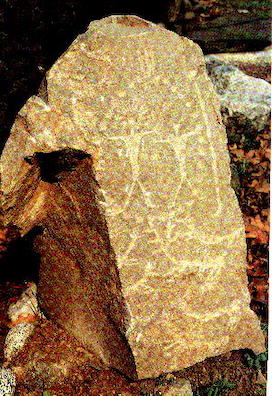Museum of the Origins of Man
ZOOMORPHIC AND ANTHROPOMORPHIC ENGRAVINGS ON ROCK WALL IN THE POST-PALEOLITHIC
 Fig. 33A2) Rupestrian graffito, Mount Bego, France. It depicts a man plowing.
Fig. 33A2) Rupestrian graffito, Mount Bego, France. It depicts a man plowing.
Size: these graffiti, about 35,000, are all small. The man depicted should be about 15 cm tall.
Dating: 1800-1600 BC.
Material Culture: Bronze Age.
NOTE:
1) The entire typology of the rock engravings of Mount Bego (mainly heads of bulls with U-shaped horns, then weapons and equipment, such as halberds, scythes, axes and daggers; the human figures are 1%) has a representation from the top and not in profile.
2) Despite the schematic and of easy execution style, we believe that these graffiti are the work of pilgrims, and not of artists, as in the in the Paleolithic paintings
 Fig. 33A3) Stele with graffiti of men and animals, Val Camonica, Italy.
Fig. 33A3) Stele with graffiti of men and animals, Val Camonica, Italy.
It is a scene with two figures open arms, of which the major has his head surrounded by a solar halo.
"Stele" from Masso Cemmo 4.
Rock size: height cm 70, width cm 42; therefore the human figures are about 20 cm high.
Dating: III millenium BC
Material Culture: Copper Age.
NOTE: The Val Camonica's graffiti extend for about 70 km, between 400 and 1000 m of altitude.
There are about 130,000, to which others have been added after 16 BC, with the conquest and settlement by the Romans. Today there are about 300,000 of them.
The oldest date back to 8000 BC (10,000 years ago), which was deducted from 4 moose scratched, animals recalling the glacial climatology, still close in time.
In Val Camonica the animals are depicted sideways, differing from those of Mount Bego, which have representation from the top.
NEXT
Index
HOME PAGE
Copyright©1999-2020 by Museum of the Origins of Man, all rights reserved.


